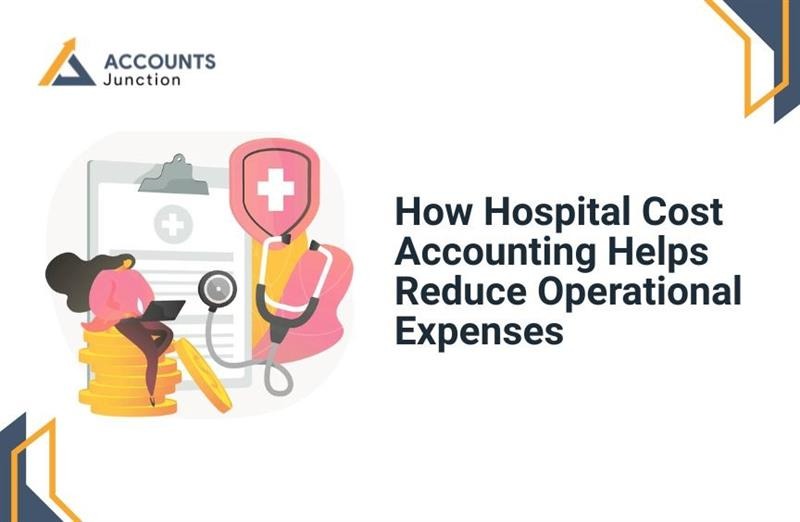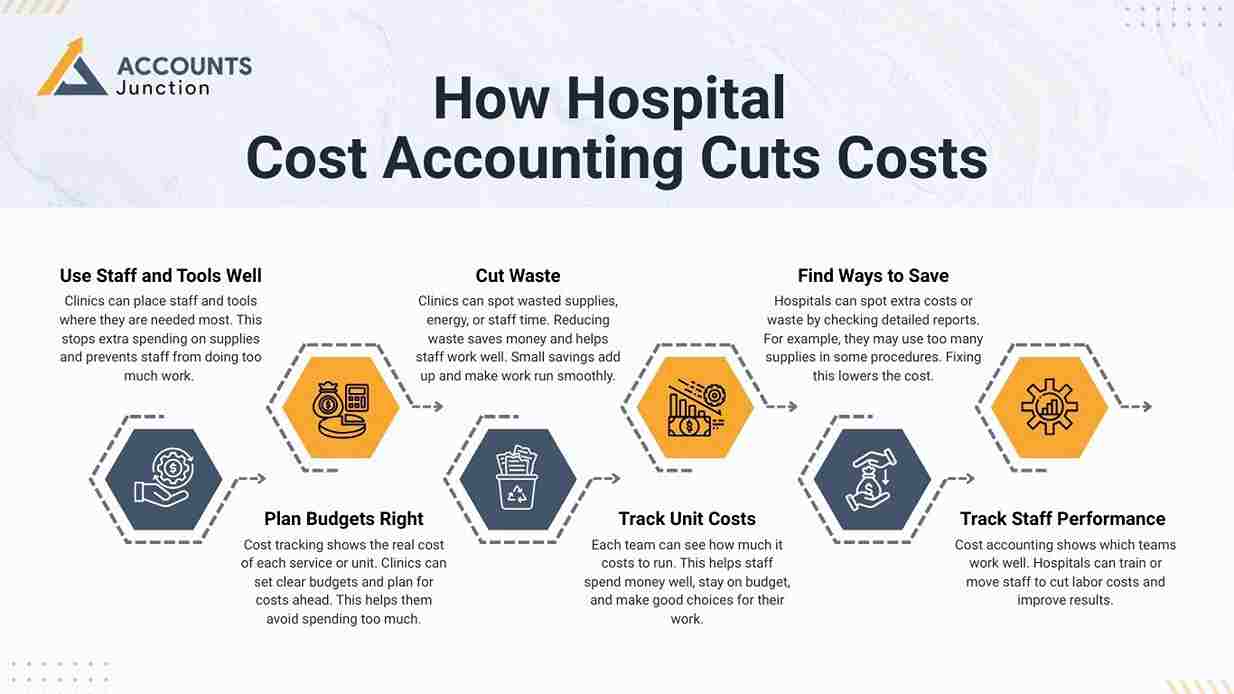
How Hospital Cost Accounting Helps Reduce Operational Expenses
Clinics want to give the best care while using staff, tools, and money well. Smart cost tracking helps work run smoothly and keeps spending low. Hospital cost accounting shows all costs and helps leaders find ways to save money. It tracks direct costs, like staff pay and medicine, and indirect costs, like power, cleaning, and office work. By knowing the true cost of each service and team, clinics can plan budgets and make smart choices.
In this blog, we will see how hospital cost accounting works, the main costs it tracks, the tools clinics use, and the ways it helps save money and run work more smoothly.
What is Hospital Cost Accounting?
Hospital cost accounting is a method to keep track of all the money a hospital spends. It shows where the money goes and which areas use the most funds. This helps hospital leaders plan well, make smart choices, and save money.
Parts of Hospital Cost Accounting
1. Direct Costs
Direct costs are the expenses tied to patient care. They include:
- Medicines and medical supplies
- Staff salaries
- Medical tools and equipment
Tracking these costs helps hospitals spend money wisely and lower expenses without affecting patient care.
2. Indirect Costs
Indirect costs are needed for the hospital to run, but are not tied directly to patients. They include:
- Electricity and water
- Cleaning and maintenance
- Office staff and admin work
Watching these costs helps reduce waste and manage money better.
3. Cost Allocation
Cost allocation spreads indirect costs across different departments. It helps:
- Show the true cost of each department
- Make better spending decisions
- Use resources more efficiently
This gives hospitals a clear view of expenses and helps control costs.
How Hospital Cost Accounting Cuts Costs
Cost tracking shows all spending in a clear way. It helps clinics save cash and use staff, tools, and supplies well. By tracking costs, leaders can see where money goes and find ways to spend less.
1. Use Staff and Tools Well
Clinics can place staff and tools where they are needed most. This stops extra spending on supplies and prevents staff from doing too much work. Using staff and tools well helps clinics give good care while keeping costs low.
2. Plan Budgets Right
Cost tracking shows the real cost of each service or unit. Clinics can set clear budgets and plan for costs ahead. This helps them avoid spending too much.
3. Cut Waste
Clinics can spot wasted supplies, energy, or staff time. Reducing waste saves money and helps staff work well. Small savings add up and make work run smoothly.
4. Track Unit Costs
Each team can see how much it costs to run. This helps staff spend money well, stay on budget, and make good choices for their work.
5. Find Ways to Save
Hospitals can spot extra costs or waste by checking detailed reports. For example, they may use too many supplies in some procedures. Fixing this lowers the cost.
6. Track Staff Performance
Cost accounting shows which teams work well. Hospitals can train or move staff to cut labor costs and improve results.
How It Helps Daily Hospital Work
Hospital cost accounting helps hospitals not only with long-term plans but also with daily tasks. It gives clear data that makes day-to-day choices simple and makes work more efficient.
-
Department Efficiency
Each hospital department has its own costs. Cost accounting shows them clearly. Departments that spend too much can spot problems and fix them fast.
-
Better Staff Use
Hospitals can plan staff shifts and work hours using cost data. This lowers overtime and keeps care quality high.
-
Cut Waste and Overhead
Cost accounting shows areas of waste, like unused supplies, extra energy use, or extra office costs. Hospitals can reduce these to save money.
-
Improve Supply Management
Hospitals can track stock levels of medicines and tools. This prevents shortages and avoids overbuying.
-
Track Service Costs
Cost accounting lets hospitals see how much each service or procedure costs. This helps in pricing and budgeting.
-
Quick Financial Decisions
With up-to-date cost data, hospitals can make fast decisions for purchases, staff allocation, or repairs. This keeps work smooth and costs low.
-
Monitor Department Performance
Hospitals can compare how different departments use money. Departments that spend well can be models for others.
How Does Cost Data Improve Hospital Decisions?
Hospital cost accounting gives clear data to guide smart choices. Leaders can see where money goes and which areas need care. This helps hospitals plan budgets that match real costs and avoid extra spending.
Cost data shows which services cost the most and which give the best value. It helps hospitals decide where to add staff, buy tools, or grow services. It also shows where supplies, energy, or staff time are wasted.
Accurate cost data helps with daily work and long-term plans. Departments can stay on budget and work better. Staff who know costs use time, tools, and money well. This leads to smooth work, better care, and lower total costs.
Tools Used in Hospital Cost Accounting
Hospitals use simple tools to make cost accounting easier.
-
Activity-Based Costing
This shows the cost of each activity or service. Hospitals see which activities cost more and find ways to cut costs.
-
Standard Costing
This compares real costs to planned costs. Hospitals find extra spending and stop it fast.
-
Software Tools
Modern software helps track costs and make reports. Hospitals can see trends and decide quickly.
Challenges and Best Tips in Hospital Cost Accounting
Hospital Cost Accounting helps hospitals save money and run well. But some challenges can make it hard to use. Here are the main ones and simple tips to deal with them.
1. Hard Work in Hospitals
Hospitals have many units and tasks. Tracking all costs can be hard.
Tips: Break work into small steps, track each unit on its own, and check high-cost areas often.
2. Staff Who Resist Change
Some staff may not like the new ways. This can slow cost tracking.
Tips: Give short training, show staff how it helps work, and praise staff who use it well.
3. Need for Correct Data
Cost tracking works only if the data is right. Wrong numbers can cause bad choices.
Tips: Keep clear records, check numbers often, and use simple tools to avoid mistakes.
4. Engaging Staff in Cost Use
Staff may not follow cost rules if they see no gain.
Tips: Let staff join in planning, show easy reports, and make cost work part of daily tasks.
5. Checking Costs Often
Without checks, costs can go wrong or rise too high.
Tips: Compare spending to the plan each week, fix errors fast, and update plans when needed.
Hospital cost accounting helps hospitals save money, use staff and tools wisely, and cut waste. It gives clear data to plan budgets, track costs, and make smart daily decisions.
At Accounts Junction, we offer hospital cost accounting services that are clear and efficient. Our certified experts track all costs, review spending, and use innovative tools to keep records accurate. Hospitals get better control of money, improve care, and stay strong. Partner with us for clear reports, wise choices, and steady growth.
FAQs
1. What is Hospital cost accounting?
- It is a way to track all the money a hospital spends.
2. Why do hospitals need cost accounting?
- It helps them save money and plan budgets well.
3. What are direct costs?
- Costs tied to patient care, like staff pay and medicines.
4. What are indirect costs?
- Costs for running the hospital, like electricity and cleaning.
5. What is cost allocation?
- It spreads indirect costs across departments to show real expenses.
6. How does cost accounting reduce waste?
- It shows where supplies, energy, or staff time are overused.
7. How does it improve staff use?
- Hospitals can plan shifts and work hours better, reducing extra pay.
8. Can it help plan budgets?
- Yes, it shows real costs so hospitals can plan and avoid overspending.
9. How does it track department costs?
- Each department’s spending is recorded and monitored.
10. Does it help with daily hospital work?
- Yes, it gives data for fast decisions on staff, tools, and purchases.
11. What tools do hospitals use for cost accounting?
- Activity-based costing, standard costing, and software tools.
12. What is activity-based costing?
- It shows the cost of each activity or service in the hospital.
13. What is standard costing?
- It compares real costs with planned costs to find overspending.
14. How does software help?
- Software tracks costs, shows trends, and creates reports fast.
15. What are the main challenges?
- Complex work, staff resistance, and the need for correct data.
16. How does it improve supply management?
- Hospital Industry can track stock, avoid shortages, and stop overbuying.
17. Can it reduce unnecessary services?
- Yes, it shows which tests or treatments are overused.
18. How does it monitor performance?
- Departments can see spending and learn from efficient teams.
19. Does it help cut overhead costs?
- Yes, it shows extra office, energy, or admin costs to reduce.
20. Why is hospital cost accounting important?
- It keeps hospitals financially healthy and ready for the future.

